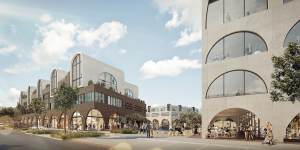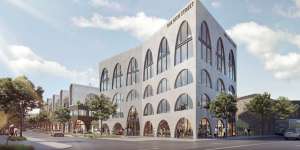Five years later,the reality is more eat street than arts precinct:the former timberyard in Marrickville’s Rich Street is to become home to a gelato factory and a probable gin distillery.

The Rich Street project aimed to attract businesses and creatives being priced out of the area. Supplied
Hip-hop artist Urthboy,aka Tim Levinson, to express regret for his public support for the cultural hub. He has questioned why planners and politicians are unable to hold the developer to its original plans.
“I believe that the people genuinely wanted to make that[project] happen but I also know that as soon as it was discarded,there was no one with any leverage standing up for the arts community.”
Rich Street is on the frontline of a development push in Marrickville that has put musicians,performers and artists in retreat and struggling to find new affordable footholds in the suburb they have made home.
Developer Danias Holdings has put on hold its near Factory Theatre,citing COVID-19’s devastating impacts for the loss of potential anchor arts tenants that would have made the project commercially viable.
The developer is building temporary factory sheds for food and beverage facilities including an artisanal gelato production house until market conditions improve.
Inner West Mayor Darcy Byrne said a state government panel had approved the creative hub three years ago. “The landowners promised the local community this would be delivered and they should keep their word and get the hub opened so that artists can make use of it.”
In 2019,approval was given for three new buildings of commercial and public and creative space,delivered in two stages,including an outdoor green with stage,studios,a pop-up gallery providing makers,start-ups and creatives an on-site exhibition space to showcase their wares. The developer has seven years to proceed before the development approval lapses.
“Following approval,expressions of interest were sought from interested creative industry companies looking for long-term leases to locate in the hub. However,with the onset of the COVID-19 pandemic,all interested companies withdrew,” said Angelo Angelopoulos from Danias.

Artist impression of the Rich Street Cultural Precinct. Marrickville.Supplied
“Without a critical mass of tenants committed to long-term leases it is not possible to proceed with construction at this stage. We remain committed to proceeding with building the hub when market conditions improve. In the interim,some temporary sheds have been put on the site to provide some activation and improve the local amenity.”
Leaving the site vacant was not in anyone’s interest,Angelopoulos added.
With the promise of affordable art-making spaces,Levinson had hoped that the new creative hub would offset the loss of creative spaces in the neighbouring streets of Marrickville.
His label,Elefant Traks,was forced to quit its nearby premises last month after it was sold for new industrial workspaces,retail and storage.
“We found another place in the area,but we are paying twice the amount of rent,” Levinson said. “It’ll change the nature of our business. It’s a run-of-the-mill story in Sydney,the way that development takes precedence over all other considerations of the community to the point where people devalue quality of life.
“Part of the energy you create by bringing your art to a community,and I’m acknowledging the artist’s role in gentrification,is that you become a Trojan horse for developers to come in and capitalise off the vibrancy that artists create.
“Artists are used to begging,borrowing and stealing to survive,but there should be a balance where their vitality is preserved and valued in the overall health and expression of local neighbourhoods.”
Chris Gibson,professor of human geography at the University of Wollongong,has been tracking Sydney’s industrial heartland and found the City of Sydney and Marrickville lost half its industrial spaces to redevelopment between 2011 and 2019.
Offers of compensatory affordable cultural spaces were for the most part a “token gesture”.
Replacement spaces for cultural tenants were not always “affordable,accessible,malleable and physically suitable for potential occupants that were otherwise displaced from what was there previously,” he said.
A cultural guide to going out and loving your city..
